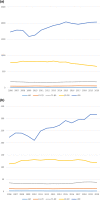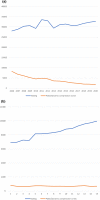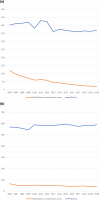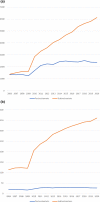The development, incidence and treatment trends of trochanteric fractures in Germany: a cohort study
- PMID: 37430277
- PMCID: PMC10331963
- DOI: 10.1186/s13018-023-03981-5
The development, incidence and treatment trends of trochanteric fractures in Germany: a cohort study
Abstract
Background: Hip fractures are a major public health problem worldwide and can lead to disability, increased mortality, and reduced quality of life. We aim to provide a nationwide epidemiological analysis of trochanteric and subtrochanteric fractures and their respective surgical treatments.
Methods: Data were retrieved from the national database of the German Department of the Interior. ICD-10-GM and OPS data from the period of 2006 to 2020 were analysed and all patients with trochanteric and subtrochanteric fractures as their main diagnosis, who were treated in a German hospital, were included. Patients were grouped by age and gender and linear regression was performed where suitable to calculate statistically significant correlations between variables and incidences.
Results: 985,104 pertrochanteric fractures and 178,810 subtrochanteric fractures were reported during the analysed period. We calculated a mean incidence of 80.08 ± 6.34 for pertrochanteric and 14.53 ± 1.50 for subtrochanteric fractures per million inhabitants. In both fracture types, a distinct dependence of incidence on age can be determined. Incidence rates equally rise in both sexes through the age groups with an increase of about 288-fold from those under the age of 60 to those over the age of 90 in pertrochanteric fractures, and about 123-fold in subtrochanteric fractures. Intramedullary nailing was the most common kind of treatment for both fracture types with augmentative cerclages on the rise throughout the whole period. Plate and dynamic compression screws were decreasing in frequency over the analysed period in both fractures.
Conclusions: We provided incidence data on per- and subtrochanteric fractures and their treatment. We calculated an economic impact of approximately 1.563 billion € per year in Germany. With regards to recent literature on costs of treatment and our findings regarding the implementation and utilization of different treatment methods, we conclude that the reinforcement of nationwide prevention programs is a relevant step in lessening the economic burden. We welcome the increased utilisation of intramedullary nailing as many studies show beneficiary outcomes and cost effectiveness in most of the included fracture types.
Keywords: Epidemiology; Incidence; Osteosynthesis; Trauma; Trochanteric fractures.
© 2023. The Author(s).
Conflict of interest statement
There are no competing interests present.
Figures




Similar articles
-
Cephalomedullary nails versus extramedullary implants for extracapsular hip fractures in older adults.Cochrane Database Syst Rev. 2022 Jan 26;1(1):CD000093. doi: 10.1002/14651858.CD000093.pub6. Cochrane Database Syst Rev. 2022. PMID: 35080771 Free PMC article.
-
Falls prevention interventions for community-dwelling older adults: systematic review and meta-analysis of benefits, harms, and patient values and preferences.Syst Rev. 2024 Nov 26;13(1):289. doi: 10.1186/s13643-024-02681-3. Syst Rev. 2024. PMID: 39593159 Free PMC article.
-
What Factors Are Associated With Implant Revision in the Treatment of Pathologic Subtrochanteric Femur Fractures?Clin Orthop Relat Res. 2025 Mar 1;483(3):473-484. doi: 10.1097/CORR.0000000000003291. Epub 2024 Oct 22. Clin Orthop Relat Res. 2025. PMID: 39437551
-
Surgical interventions for treating extracapsular hip fractures in older adults: a network meta-analysis.Cochrane Database Syst Rev. 2022 Feb 10;2(2):CD013405. doi: 10.1002/14651858.CD013405.pub2. Cochrane Database Syst Rev. 2022. PMID: 35142366 Free PMC article.
-
Interventions for treating femoral shaft fractures in children and adolescents.Cochrane Database Syst Rev. 2014 Jul 29;2014(7):CD009076. doi: 10.1002/14651858.CD009076.pub2. Cochrane Database Syst Rev. 2014. PMID: 25072888 Free PMC article.
References
-
- Wu AM, Bisignano C, James SL, et al. Global, regional, and national burden of bone fractures in 204 countries and territories, 1990–2019: a systematic analysis from the Global Burden of Disease Study 2019. Lancet Healthy Longev. 2021;2(9):e580–e592. doi: 10.1016/S2666-7568(21)00172-0. - DOI - PMC - PubMed
-
- WHO. World population prospects 2019. PD Department of Economic and Social Affairs, Editor. Published online 2019
MeSH terms
LinkOut - more resources
Full Text Sources
Medical

